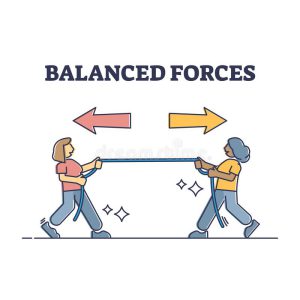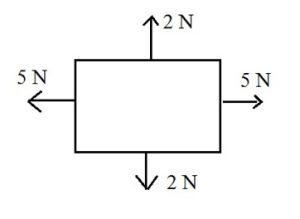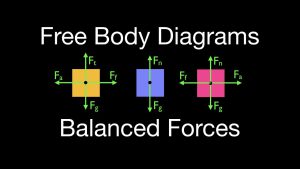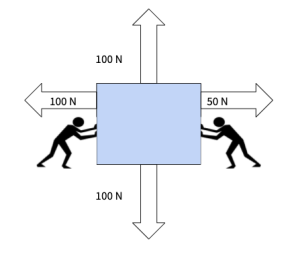Last Updated on August 22, 2025 by Muhamed Elmesery
“Force” is one of the very essential terms used in physics. Every time and everywhere we—as scientists, or as a public crowd—are about to observe or examine a phenomenon closely, we find that a force is controlling or resulting in that phenomenon.
Forces are instinctively different from each other; they have many forms, and their presence is significant in almost everything in our everyday life.
One of the physics bright stars of all time is the set of Newton’s laws of motion, consisting of his three very well-known laws; all of these laws discuss forces and how they interact and react, but do you know what are the many types of forces that exist and are known by scientists?
Get started Praxilabs for FREE
Forces exist in two forms, either as a result of contact interactions, i.e., normal, tensional, frictional, and applied forces; or as a result of actions-at-a-distance interactions, existing in the form of electrical, gravitational, and magnetic forces.
In general, forces are the reason causing objects to stay still, to move at a fixed rate, or to accelerate, whether by speeding up or slowing down.
How many times have you tried to pull the rope from the hands of your rival, and you won? And how many times have you tried but ended up with both of you just pulling for a long time with no one really winning the competition?

Balanced and unbalanced forces are the answer why this happened. They are accounted for to be present in many forms around us and are considered to be controlling the force flow between any two—or more—interacting objects.
Questions like: what is the difference between a balanced and unbalanced force acting on an object? What are the balanced force characteristics? Is kicking a soccer ball an unbalanced force? Might be crossing your mind now… Do not worry, as in this article, we will discuss all the information you are looking for and answer all your questions!
Table of Contents
What Is a Balanced Force?
Let’s start with an example to elaborate what a balanced force is. Imagine a box—i.e., the one in the picture below—that is acted upon by forces from all directions, and the resultant of these forces sums up to zero at the end. Thus, the box is standing still at its place, without exerting any movement or accelerating.

In our example, the forces which act on both the left side and the right side are of the same magnitude (5 Newtons), but in opposite directions. The same goes for the forces acting on the upper and lower sides (2 Newtons).
Recalling Newton’s first law of motion, it is stated and acknowledged that:
“An object at rest stays at rest and an object in motion stays in motion with the same speed and in the same direction unless acted upon by an unbalanced force.”
On the other hand, if all the pushes and pulls are balanced by one another in all the directions, it means that the forces are balanced. That is to say, if we put a book on the table, this book remains in its place without moving. While it is under the influence of two forces:
- The gravitational force, pulling it downward, and
- The force exerted by the table itself on the book, pushing it upward.
Both are acting with the same magnitude, but again, in opposite directions.
Balanced Force Definition
Back to our main question: how a balanced force is defined?
Balanced force is defined as the resultant of all the forces that acts on a body or an object, and sums up to zero, without causing this body or object to move, accelerate, or change its direction, size, or shape.
The force’s unit is the Newton, denoted by an N, and it can be measured using a device known as: a force meter. Not to forget that force is a vector quantity—needs both direction and magnitude to be fully expressed.
Balanced forces are a type of force that are equal in size and opposite in direction. It also results in what is known as unchanging motion.
Force Diagram of Balanced Forces
One of the force’s strength points is that it can be represented using diagrams or pictures, where the force is symbolized by an arrow.
The arrow’s size relies on the force’s magnitude or measurement. While the arrow’s direction represents the direction where the force acts.

In force diagrams, force arrows can be added or subtracted to determine the net force acting on the object or the body! This happens as follows:
-
- If the forces are in the same direction, they are added, and the net force is the summation of the forces. Since the acted forces are in the same direction, the net force will also be in the same direction.
- If the forces are in opposite or different directions, the net force is hence found by subtracting the smaller force from the larger one. This type of force is useful in changing the characteristics of the body or the object, i.e. its magnitude of velocity, its size or shape, and its direction of motion.
- If the forces are in the same direction, they are added, and the net force is the summation of the forces. Since the acted forces are in the same direction, the net force will also be in the same direction.
As a consequence, we expect that the body or object will not change its direction, magnitude of velocity, nor its shape or size, as long as it was not moving prior to being acted upon by a balanced force.
Force diagrams are useful when we analyze the forces, and they are pivotal when you are dealing with a complex problem, or when too many forces are acting on the body or the object of your interest.
Balanced Force Examples
What do you expect if you are pushing a wall with all your power? The wall does not move, it stays still, and so do you! This happens because both you and the wall exert a balanced force on each other.
That is to say, anything that is not moving or continues to move at a fixed rate and in the same direction does experience a balanced force.
Examples of balanced force are abundant around us, and are obvious in our every day’s live. Such as:
- Doing a handstand, or a headstand (without falling down),
- A running car staying still in its place because you are applying the brakes,
- A body or an object floating on the water’s surface,
- A person standing or sitting still in his/her place,
- Planets orbiting the sun in a fixed orbit,
- A vehicle that continues to move at the same unchanged speed,
- The framed pictures hanged on your room’s wall,
- A jacket hanged on the coat’s hook,
- A tug of war game, where neither side is winning, and
- An aircraft in a steady-flight.
More examples can continue to be mentioned but, are we really able to obviously track the many forms of balanced force in our everyday lives?
Friction… and How It Affects Balanced Force
The reason why we cannot clearly track the work of balanced forces in our everyday lives is because of this magic word: friction.
Friction plays an important role in stopping the balanced forces work. Imagine giving your shopping cart a good and strong push expecting it to be rolling all over the supermarket. This does not happen, instead, the cart stops in the middle of its way, and this is caused by a type of force that comes to play: friction.
It is not the same situation when you happen to be floating in space, i.e. an astronaut maybe!
In space, the astronaut cares the slightest about the bodies and objects floating for as much as it takes: forever! Since there is little or almost no friction resisting objects’ motion, they will keep floating till the end of the time, unless acted upon by a resisting force.
On earth, and whilst planning for a big scientific or engineering project, we account and pack very much for friction, and its consequences. Nevertheless, we still have examples where balanced force takes control.
We thus conclude that unbalanced forces are remarkably easy to notice around us, everyday, and everywhere.
What Is an Unbalanced Force?
You might now have a glimpse of what an unbalanced force really is, as you may think about it as the opposite thing to the balanced force, which is logically true to think of.
Similarly, an unbalanced force is a type of force that causes any body or object to change its state, its magnitude of velocity, its direction, or to accelerate, whether by speeding up or slowing down. This type of force is almost everywhere around us, as it works hand in hand with the force of friction.
Recalling the previously mentioned shopping cart example, we now conclude that the cart faces an unbalanced type of force which causes it to decelerate, until it finally stops.
All in all, what is the right definition for an unbalanced force?
Unbalanced Force Definition
To state a definition for the unbalanced force, you need to bear the concept of resultant force in your mind, as it is the cornerstone on which unbalanced forces rely on.
Unbalanced force is defined as the resultant of all the forces that acts on a body or an object, and is not equal to zero, while causing this body or object to move, accelerate, or change its direction, size, or shape.
Force Diagram of Unbalanced Forces
If the forces are unbalanced, it means that the opposing pairs of forces are not of the same magnitude —one is stronger than the other—. And the body or the object subject to unbalanced forces experiences a force in one direction that is exceeding the force opposing it in the other direction.
The diagram below shows unbalanced forces exerted by two persons on a box, where the upper and lower forces are balanced, but the right and left forces are not the same.
From this simple diagram, we expect the box to be moving to the left, where the person on the right exerts a force of 100 N. Subtracting 50 N from 100 N, we thus know that the box will have a 50 N force towards the left direction.
Unbalanced forces cause a change in motion for the object, where the stronger force wins over the weaker one.

Force diagrams are very insightful in explaining further information about the forces acting on a body or an object. This video discussing force diagrams will walk you through the concept, how to practically use it, and it will elaborately explain both balanced and unbalanced forces more.
Examples of Unbalanced Forces
To fully comprehend the nature of unbalanced forces, we are giving some examples:
- A group of kids winning a tug of war game,
- A car accelerating, braking, or turning,
- An object sinking in water,
- Riding a skateboard,
- Turning a cartwheel,
- A fruit dropping from a tree,
- A moving train that slows down prior to its station,
- An object getting knocked over by the wind, and
- A football sailing toward the goal after it was kicked.
Check Your Understanding!
Practicing and testing your understanding is the only way that allows you to know if you did really grasp the topic, or if you still need to read and understand it more… here are some phrases where you need to determine if the described forces are balanced or unbalanced:
- An item rolls off the surface it was placed on.
- A swing swaying in the breeze.
- Tossing a rock so that it skips against the water.
- A computer monitor stays in its place on a desk.
- A skater does a double axel.
- A backpack hanging from a hook.
- A bicycle being ridden at a set speed down a straight road.
Write your answers down, and let’s figure out if they were right or wrong!
- Unbalanced, as gravity will overcome the friction between the item and the table.
- Unbalanced, as the gravity pulls the swing down, it still moves back and forth, while the breeze pushes it forward and up.
- Unbalanced, as the rock will slow down every time it skips until it sinks.
- Balanced, where the monitor does not change its motion—it just sits there.
- Unbalanced, as the skater moves in a circle (rotation) until the friction between the ice and the skates finally stops the rotation.
- Balanced, where the force attaching the hook to the wall (either screws, nails or glue) is balanced with the force of gravity.
- Balanced, since the bike is not changing speed or direction, so the force of friction between the tires and the road is balanced by the force you put into the pedals (also, the rider is exerting force to overcome wind resistance).
Little by little, we figured out that force is a necessity in everything around us, and it rules everything. It also results in various actions, i.e., magnetic fields and electric fields… etc. and we knew how to approach force more actively.
Demystifying Balanced and Unbalanced Forces: Your Essential FAQs Covered
Which could be an example of a balanced force?
Here is an example of a balanced force:
If you pushed against an empty soda can in one direction, and a friend pushed against it in the opposite direction with an equal amount of force (the same magnitude). In this case, the can wouldn’t move (but the two opposing forces would probably crush the can)
Sitting on a surface, hanging objects, standing on a surface, and planets orbiting the sun in a fixed orbit are other examples of a balanced force.
Which is an example of balanced forces acting on an object?
Standing on the floor is a good example of balanced forces acting on an object. In this example, there are 2 forces acting upon the person standing on the floor. The floor exerts an upward force and the force of gravity exerts a downward force. Since these 2 equal forces in opposite directions, they balance each other.
What is the difference between a balanced and unbalanced force?
| Balanced Forces | Unbalanced Forces |
| In balanced force, the resultant of all the forces that acts on an object is equal to zero and causes this object to move, accelerate, or change its direction, shape, or size. | In an unbalanced force, the resultant of all the forces that acts on an object is not equal to zero and causes this object to move, accelerate, or change its direction, shape, or size. |
| It does not make any change in the rest of the body and the motion state. | It can make a change in the rest of the body and the motion state. |
| It can’t accelerate a body or object. | It can accelerate a body or object. |
| It can’t initiate motion. | It can initiate motion. |
What is an unbalanced force?
Unbalanced force is the net of forces that are not equal in size and differ in the direction. The net force here is not equal to zero and causes the object to move, accelerate, or change its direction, shape, or size.
What are examples of an unbalanced force?
Here are some examples of an unbalanced force:
- Riding a skateboard.
- A basketball approaches a hoop.
- An apple dropping from a tree.
- A bowling ball striking pins.
- A windsurfer moving on the ocean surface.
- A tennis ball in flight.
- A moving train that slows down prior to its station.
- A basketball approaches a hoop.
Who discovered balanced and unbalanced forces?
It’s difficult to say that a single scientist discovered balanced and unbalanced forces. Understanding and clarifying the concepts of forces and their effects developed gradually throughout history. However , let’s take a look at some of the most significant scientists who played critical role on our understanding of balanced and unbalanced forces:
Galileo Galilei played a very important role in our understanding of motion, gravity, and mainly inertia which is very critical in understanding balanced and unbalanced forces.
Isaac Newton, with his three well-known laws of motion, further discussed how forces interact and react. These laws are built upon Galileo’s ideas on motion. Newton proved that an object would continue to move even if no force acted on it, and also more than one force can act on an object simultaneously..
What is the balanced and unbalanced forces?
To understand the definition of balanced and unbalanced forces, first let’s define “force in physics”. Force is an external factor that can change a body’s state of rest or motion and it has both direction and magnitude.
Balanced force is the net of all the forces that act on a body or an object, and is equal to zero, causing the body or object to remain at rest or move, accelerate, or change its direction, size, or shape. The net forces cause no movement as equal and opposite forces cancel each other out.
Unbalanced force is the net of all the forces that acts on a body or an object, and is not equal to zero, causing this body or object to move, accelerate, or change its direction, size, or shape. The net forces do not cancel each other out, leading to a change in motion.
What is another real world example of balanced and unbalanced forces?
Another real world example of balanced force is a book resting on a table, because there are two forces acting upon the book. The upward force exerted by the table is equal (in magnitude) and balanced by the force of gravity pulling the book downwards but opposite in direction, resulting in a net force of zero.
Another real world example of unbalanced force is kicking a ball. If you kick the ball with a force greater than the force of friction acting against it, the ball will accelerate in the direction of your kick due to the unbalanced force you’re applying.
Why do you think both balanced and unbalanced forces are important in everyday life?
Balanced and unbalanced forces are important in everyday life observations, as they play a critical role in explaining the movement and stability of objects. For more clarification, the balanced forces are responsible for maintaining the objects’ equilibrium and stability. And the unbalanced forces are responsible for changing the objects’ state of movement and more.
Guide the Best Science Lab Simulation Experience Ever with PraxiLabs
With PraxiLabs students get a full experience, with guidance and learning materials to further aid the learning process rather than simply following through and covering it.
With PraxiLabs students can actively learn while performing their experiments.
- 65% of learners are VISUAL. PraxiLabs provides various multimedia forms.
- 30% are AUDITORY. PraxiLabs uses VO guidance.
- 5% are KINAESTHETIC. PraxiLabs provides more virtual “hands-on” experience.
Create your free account and delve into more virtual experiments discussing balanced and unbalanced forces,
now with PraxiLabs!
 PraxiLabs A virtual world of science
PraxiLabs A virtual world of science






